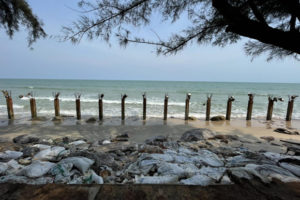
Activists battle to save beaches from construction of sea dykes on Phetchaburi’s Cha-am beach in Thailand
Civic groups say authorities are mistaken in seeing these eyesores as long-term solutions to erosion
Projects to construct sea dykes to ease beach erosion along various parts of Thailand’s coastline carry on despite clear evidence showing they are not a constructive or effective way to stop the problem, environmental activists say.
Parts of several beaches have disappeared after such projects were completed.
Examples can be found along the coast around Cha-Am beach in Phetchaburi province and along other shores in the lower Gulf such as in Songkla and NaKhon Si Thammarat, they say.
Unfortunately, building infrastructure such as dykes seems to be the preferred solution for local authorities as they can show an immediate impact.
The problem is they are only a temporary solution because beach erosion will happen again in the coming years, according to Phisanupong Laolaphpol, a coordinator of the Pak Nam Pran Sea and Beach Lover group, which is working to protect the 1.4-kilometre-long Pranburi beach near Hua Hin by stopping a seawall project there that is underway.
One of the concerns activists have about this project is that an environmental impact assessment study (EIA) is not required under the amended regulations of the Office of Natural Resources and Environmental Policy and Planning (Onep).
The office justified this move by claiming the problem of beach erosion is urgent and the EIA is too time-consuming.
Onep said it merely needs to conduct of checklist, which it claims is an abbreviated but still valid version of an EIA.
Mr Phisanupong said it is clear the sea dyke project has already “destroyed” the part of the beach it occupies, which is public property and should be protected for future generations.
“Without the beach, people don’t want to go to the sea. They want to walk on the beach and swim in the sea. But all they can do right now on Pranburi beach is take photos with the sea dyke and landscape and go back to swim at other beaches. Life hasn’t been the same since the seawall was built,” he said.
The group said it had suggested local authorities use sandbags instead of building the second, 230-metre phase of the project. The original plan was to have a 900-metre seawall with an allocated budget of 146 million baht.
The Department of Public Works and Town & Country Planning has reportedly accepted the group’s proposal.
It now plans to use sandbags for the second phase, which was due to start next year. In addition, the department will plant mangrove trees along the shore as suggested by the group, Mr Phisanupong said.
He said the group would be grateful if it could protect at least part of the beach from the project.
Sakanan Plathong, a lecturer with the Department of Biology, Faculty of Science at Prince of Songkla University, said the cabinet in 2018 set up guidelines for preventing coastal erosion by categorising measures to tackle the problem according to their level of impact.
White measures help set up buffer zones while green measures include planting mangrove forests to mitigate soil erosion. Grey measures cover hardware construction such as the sea dykes.
Most agencies tend to ignore academic advice and adopt grey measures, he said. However it is of crucial importance to conduct environmental studies in advance to ascertain how much of a negative effect these can have, he added.
“I think the best way to protect our beaches is by forming a civil society movement as these seawalls can have an immense impact. We, as academics, have voiced concerns about these projects for years, but no one listened,” he said.
“Now people are slowly waking up to the reality as they can see the self-evident facts for themselves,” he added.
Mr Sakanan said in the worst cases of coastal erosion, land reclamation is an interesting option to explore. This can restore a sense of ecological balance and stop further erosion, he noted.
Bunlung Meangbua, chief of the marine engineering design project at the Department of Marine and Coastal Resources, said the department is now shifting its focus to other options like sand-fill projects.
He cited the restructuring of a missing beach in Pattaya and said his department has conducted sand-fill projects on nearby Jomtien beach, also in Chon Buri, spanning 3km.
The department plans to add more sand on beaches in other provinces including Rayong, Phetchaburi and Phangnga in the future, Mr Bunlung said.
Source: https://www.bangkokpost.com/thailand/general/2295174/activists-battle-to-save-beaches-from-sea-dykes

